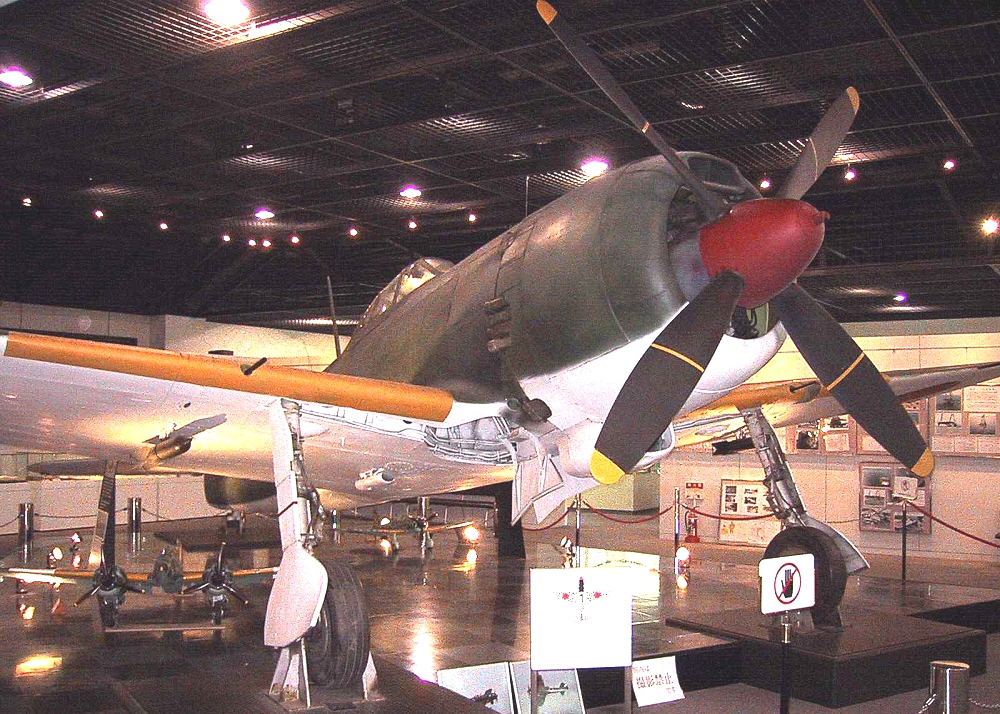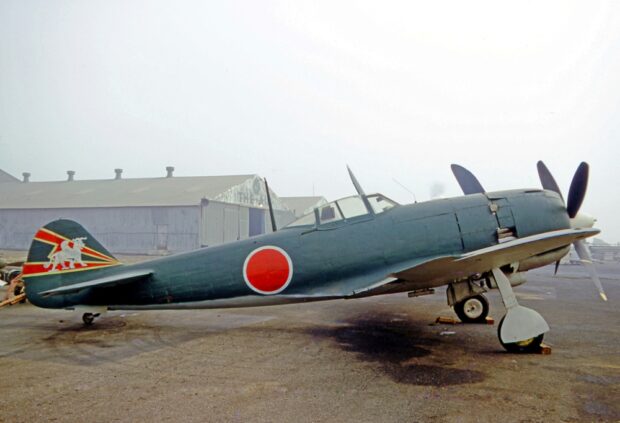By 1943, the Pacific Theater was in full swing, with the Allies forcefully attempting to take over the prized islands occupied by the relentless Japanese Empire. Using the obtained experience during the war and learning from their mistakes, the Japanese Air Force officials sought to build one last aircraft that could help them turn the tide of the war in their favour.
Enter the Nakajima Ki-84 Hayate.
The Nakajima Ki-84 Hayate (キ84 疾風, lit. “Gale”) is a single-seat fighter flown by the Imperial Japanese Army Air Service in the last two years of World War II. The Allied reporting name was “Frank”; the Japanese Army designation was Army Type 4 Fighter (四式戦闘機, yon-shiki-sentō-ki).
The Ki-84 is generally considered the best Japanese fighter to operate in large numbers during the conflict. The aircraft boasted high speed and excellent maneuverability with an armament (up to two 30 mm and two 20 mm cannon) that gave it formidable firepower.
The Ki-84’s performance matched that of any single-engine Allied fighter it faced, and its operational ceiling enabled it to intercept high-flying B-29 Superfortress bombers. Pilots and crews in the field learned to take care with the plane’s high-maintenance Nakajima Homare engine and a landing gear prone to buckling. The difficulties of Japan’s situation late in the war took a toll on the aircraft’s field performance as manufacturing defects multiplied, good quality fuel proved difficult to procure, and experienced pilots grew scarce. Nevertheless, a well-maintained Ki-84 was Japan’s fastest fighter. A total of 3,514 aircraft were built.
Design and development
Design of the Ki-84 commenced in early 1942 to meet an Imperial Japanese Army Air Service requirement for a replacement to Nakajima’s own, earlier Ki-43 fighter, then just entering service. The specification recognized the need to combine the maneuverability of the Ki-43 with performance to match the best western fighters, and heavy firepower.
The Ki-84 first flew in March 1943 and deliveries from Nakajima’s Ota factory commenced the following month. Although the design was itself solid, growing difficulties in securing skilled pilots, proper fuel and construction materials, and adequate manufacture often prevented the aircraft from reaching its full potential in the field.
The design of the Ki-84 addressed the most common complaints about the popular and highly maneuverable Ki-43: insufficient firepower, poor defensive armor, and lack of climbing speed. The Ki-84 was a cantilever low-wing monoplane of all-metal construction, except for the fabric-covered control surfaces, with conventional landing gear.
Armament comprised two fuselage-mounted, synchronized 12.7 mm (.50 in) machine guns — these proved challenging to synchronize properly with the Hayate’s four-blade propeller — and two wing-mounted 20 mm cannon, a considerable improvement over the two 12.7 mm (.50 in) machine guns used in the Ki-43 Hayabusa.
Defensive armor offered Hayate pilots better protection than the unsealed wing tanks and light-alloy airframe of the Ki-43. In addition, the Ki-84 used a 65 mm (2.56 in) armor-glass canopy, 13 mm (.51 in) of head and back armor, and multiple bulkheads in the fuselage, which protected both the methanol-water tank (used to increase the effectiveness of the supercharger) and the centrally located fuel tank.

Ki -84 “Hayate” Exhibit Room – Wikipedia/
It was the Nakajima firm’s own-designed 35.8-litre (2,180 cu in) displacement, Ha-45 Homare (“Praise” or “Honor”) air-cooled eighteen-cylinder radial engine, first accepted for military use in 1941, that gave the Hayate its high speed and prowess in combat. Derived from the Nakajima Homare engines common to many Japanese aircraft, the Hayate used the Homare 21 direct-injection version of the engine, using water injection to aid the supercharger in giving the Ki-84 a rated 1,491 kW (2,000 hp) at takeoff. This combination theoretically gave it a climb rate and top speed roughly competitive with the top Allied fighters.
Initial Hayate testing at Tachikawa in early summer 1943 saw test pilot Lieutenant Funabashi reach a maximum level airspeed of 624 km/h (387 mph) in the second prototype. In 1946, US Technical Intelligence tested a Homare Model 21-engined Hayate and achieved a speed of 687 km/h (427 mph) at 20,000 feet using 92 octane AvGas, plus methanol injection.
The complicated direct-injection engine was a compact design (only 3 cm (1.18 in) larger in diameter than the Ki-43’s 27.9 litres (1,700 cu in) 14-cylinder Nakajima Sakae radial) that required a great deal of care in construction and maintenance and it became increasingly difficult to maintain the type’s designed performance as the Allies advanced toward the Japanese homeland.
To compound reliability problems, the Allied submarine blockade prevented delivery of crucial components, such as the landing gear. Many landing gear units were compromised by the poor-quality heat treatment of late-war Japanese steel. As a result, many Hayates suffered strut collapses on landing. Further damage was caused by inadequately trained late war pilots, who sometimes found it difficult to transition to the relatively “hot” Ki-84 from the comparatively docile Ki-43, which had a significantly lower landing speed.
Top Photo: Nakajima Ki-84 Hayate N3385G wearing Japanese Air Force markings at Ontario Airport California in 1970. By RuthAS – Own work, CC BY 3.0,
Sources: YouTube; Wikipedia

